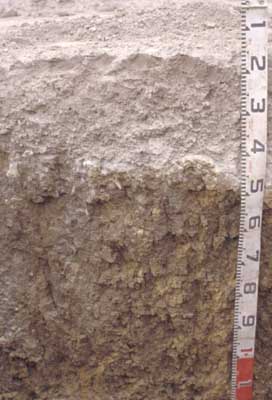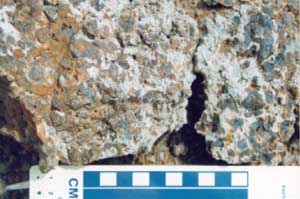SW77
In some parts of the landscape the gravel in the A2 has become cemented (pisolitic) |
| SW77 |  Bleached–Vertic, Eutrophic, Yellow CHROMOSOL | |
| 10 km east of Colac, the Colac–Forest Road | |||
| Gently undulating rises | |||
| Palaeogene Dilwyn, Eastern View Formation or Neogene Hanson Plain Sand | |||
| Very gently inclined slope | |||
| 1-2% | |||
| West | |||
Horizon | Depth (cm) | Description | ||
Ap | 0–20 | Dark greyish brown (10YR4/2 moist), greyish brown (10YR5/2 dry); fine sandy loam; apedal to weakly pedal structure; pH 5.0; clear boundary to: | ||
A2ec | 20–50 | Brown (10YR5/3 moist), conspicuously bleached (10YR7/2 dry); fine sandy loam; gravel (mixed fine quartz and rounded ironstone fragments and buckshot 2–20 mm) making up ~80% of lower 20–25 cm; pH 5.8; abrupt and wavy (amplitude <150 mm) boundary to: | ||
B21t | 50–100 | Mottled yellow (10YR7/8 moist) and red (10R4/8 moist) in ped interiors; very dark greyish brown (10YR3/2 moist) on ped faces; medium heavy clay; strong pedal structure, parting to coarse (40–100 mm) prismatic; slickensides (20–100 mm) across peds; material in soil heap very friable after rain and sun; roots to 1 m; pH 6.4; gradual boundary to: | ||
B22tg | 100 + | Matrix becoming yellower and greyer than B21 above; very pale brown (10YR7/3 moist), grey (10YR6/1 moist) red mottles still prominent; medium heavy clay; fine polyhedral structure, pH 6.4. | ||
| Management considerations | ||||
| Strong texture contrast between the surface soil and the subsoil is a very important soil feature. This can have a major effect by reducing and/or redirecting the internal drainage and restricting root growth beyond the upper horizons. Options include reduced tillage, improving organic matter content and altering the subsoil through artificial drainage (ripping, mole drainage) and/or chemical amelioration (gypsum) to improve structure. Bleached A2 horizons (or subsurface soils) are a major feature of many of soils within the Corangamite Catchment Management Authority (CMA) region. They are an indication of restricted drainage, poor soil structure (often massive) and low organic matter, nutrient and water holding capacity, nearly always in conjunction with a restrictive soil below. These bleached horizons may act as conduit for subsurface flow, particularly on sloping ground. If the soil is dispersive then gypsum application would be suitable, while increasing organic matter and maintaining vegetative cover is important. Ferruginous and ferromanganiferous nodules, concretions and pans (see the A2ec horizon in this profile) can restrict root penetration and limit available water holding capacity where there are sufficient amounts, often forming a discontinuous or continuous pan where concentrated (>50%). They are also an indication of a periodic waterlogging. Either shallow rooted species can be planted to avoid the nodules, subsoil drainage may need to be considered, possibly in conjunction with deeper rooted plants which could puncture the nodule layer and access available water and nutrients stored below. Acidic surface soils (topsoil) are often associated with sandy surfaces due the lack of base minerals and may or may not have organic matter (humose or peaty surfaces). Their acidic nature restricts the uptake of certain nutrients as well as intolerance for some plant species (due in part to the increasing mobilisation of aluminium and manganese). The application of lime is the main method of increasing the pH, reducing toxic levels of nutrients to plants while increasing the availability of nutrients such as calcium, potassium and molybdenum. Mottled subsoils are common and are an indication of periodic waterlogging, particularly if the mottles are pale (low oxygen conditions). Some brighter mottling may be due to past soil mixing and clay illuviation. Improved drainage, with the application of gypsum for sodic subsoils may be beneficial. | ||||
Analytical data
Site SW77 | Sample depth | pH | EC | NaCl | Ex Ca | Ex Mg | Ex K | Ex Na | Ex Al | Ex acidity | FC (-10kPa) | PWP (-150kPa) | KS | FS | Z | C | |
Horizon | cm | H2O | CaCl2 | dS/m | % | cmolc/kg | cmolc/kg | cmolc/kg | cmolc/kg | mg/kg | cmolc/kg | % | % | % | % | % | % |
Ap | 0–10 | 5 | 4.4 | 0.13 | N/R | 2.8 | 0.59 | 0.17 | 0.19 | 54 | 14 | 26.4 | 7.7 | 14.4 | 48.5 | 20 | 9 |
A2e | 20–40 | 5.8 | 5 | 0.06 | N/R | 1.4 | 0.67 | 0.1 | 0.11 | <10 | 4.1 | 18.2 | 4.3 | 22.1 | 47.2 | 19 | 9.5 |
B21t | 60–80 | 6.4 | 5.8 | 0.12 | N/R | 3.1 | 9.9 | 0.15 | 1.2 | N/R | 11 | 41.5 | 29.1 | 3.1 | 10.1 | 3 | 79 |
B22tg | 100–120 | 6.4 | 5.6 | 0.16 | N/R | N/R | N/R | N/R | N/R | N/R | N/R | N/R | N/R | N/R | N/R | N/R | N/R |



